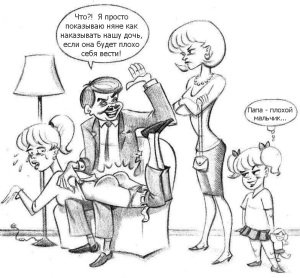Last week, we noticed how an unnamed French graphic designer drew inspiration from a previous spanking image that was itself an adaptation of a movie photograph from 1945, and how other artists used the same image as the basis for their own distinctive illustrations. Now let’s take a look at three pieces of fan art from the past decade or so:
They are all, of course, retakes on the famous and oft-sampled National Lampoon spanking cover of 1975, painted by Birney Lettick (1919-86).
(See here, here and here for yet more borrowings from this source. And see here for the other source of the second picture.)
Likewise, here’s an advertisement for a 2013 concert in Pennsylvania:
And an illustration by the Israeli artist Doron Porat Erez for a project on ‘chauvinism versus feminism’:
They’re both channeling this classic 1940s image by the Philadelphia stock photographer Harold M. Lambert:
And it goes on. Recognize these?
Both are versions of a spanking panel from a 1968 Just Married romance comic book.
Or this?
It began life as a self-portrait by the Dutch photographer Fashion Sloerie.
Here’s one…
… that draws on a splendid painting commissioned by MGM in 1945 to publicize their William Powell-Myrna Loy comedy thriller The Thin Man Goes Home:
This T-shirt design…
… is loosely based on an image shot in a Puerto Rican hotel by photojournalist Ana Maria Abruña Reyes:
And this piece of Wonder Woman fan art…
… was originally a tribute to Bettie Page by Los Angeles photographer Austin Young:
There are several things that must be said about this phenomenon. The first, important in a litigious culture obsessed with plagiarism, is that the derivative artists are not mere ripoff merchants. Many of them bring their own style and originality to the works they create. Take this piece of clean, economical draftsmanship:
Yes, it boils down a picture from 2009’s great FEMEN spanking protest in front of the Ukrainian Ministry of Education:
But it’s also a distinctive, different picture in its own right, the product of the artist’s skill and labor as much as his ability to copy a pose.
Here’s another instance of a very thorough act of reimagination by the debtor artist. If the celebrated Archie illustrator and spanking cartoonist Dan DeCarlo (1919-2001) had drawn a spanking in the modern fetish idiom, what would it have looked like? Probably something like this:
What’s clever about the picture is not just the way the illustrator, Canadian cartoonist Sherwin Tjia, has changed the usual wholesome trappings for bondage gear, but how the image looks like a familiar piece of DeCarlo’s work, yet isn’t: you just can’t put your finger on a single source – because in fact it’s a combination of two different cartoons. The spanker comes from this one…
… but the girl is from this one:
This kind of thing is not any kind of plagiarism, and it’s certainly not a desperate skill-substitution measure adopted by clueless, talentless wannabe artists. Obviously this next picture was a product of the joint creativity and talents of photographer Ellen von Unwerth and models Ana Beatriz Barros and S. Claus Esquire:
But it also took creativity, of a different kind, to produce this no less attractive image:
The second point to make is that this isn’t a recent phenomenon arising from the easy online accessibility of spanking imagery (and, let’s face it, any imagery that an illustrator might conceivably need). Professional artists have always used reference images, right back to the old masters, and in spanking illustration we can trace this some way back through the twentieth century.
Here’s a detail from a cover painting for an Italian magazine of the 1970s or 1980s.
The artist’s source was a period photoshoot done in the 1970s. The original found its way onto the cover of a somewhat dubious publication:
(Perhaps I should add that I believe both models to be of appropriate and legal age! Perhaps I should also add that it’s an eighteenth-century spanking, not Victorian at all!)
Borrowing also occurred in the world of risqué cartoons. Here’s one, unsigned, from an issue of French Fun published in about 1970 (and discovered in 2016 by the Chicago Spanking Review):
The artist was reworking a cartoon by Homer Provence (1919-75) from one of the Humorama range of comical digests, probably of the early 1960s:
Back in 1956, we find the illustrator Bill Ward (1919-98) drawing spanking toons for Humorama. He derived some of the spanking poses from late 1940s issues of glamor magazines like Beauty Parade.
Less well known than Ward in spanking circles, but better known in real life, was the American commercial painter Richard F. Williams (1908-81). He turned to Hollywood’s publicists to provide a spanking pose for this magazine illustration:
The same idea occurred to these anonymous 1940s line artists for American newspaper columns:
An illustration for an unidentified love story magazine of the late 1930s or early ’40s…
… borrowed from this splash page in a 1937 edition of Liberty Magazine:
And in 1930, the cover artist for the American ‘spicy’ pulp Hot Stories…
… turned for inspiration to a composition by Chéri Hérouard (1881-1961) that appeared in a 1925 issue of the legendary French magazine La Vie Parisienne:
Now, let’s get some perspective on this by thinking about some other kinds of creative transaction between artists. For instance, sometimes they appropriate ideas. Here’s a cartoon by Hal Money from a 1977 edition of the long-running risqué humor magazine Sex to Sexty:
And here’s a later version of the same joke:
I suspect the Russian dialog may be a later addition (or translation), but the father is saying, ‘What? I’m only demonstrating to the babysitter how to punish our daughter if she misbehaves!’ while the daughter, worldly wise beyond her years, is thinking, ‘Papa – bad boy…’
My point is that both cartoons share the same concept and tone, so closely that one artist has clearly borrowed from the other, and yet visually they are completely independent works.
This is often a trickle-down process, from mainstream originator to imitative enthusiast. But not always. A case in point involves the least creative, least imaginative genre of spanking imagery to be found online. I rarely enjoy spanking porn and don’t actively seek it out, but the stuff is really hard to avoid… Well, anyhow, here’s a photo that came up on a chance encounter and intrigued me. I was sure I knew where the idea came from.
Obviously they can only have gotten that concept from FEMEN’s 2009 protest, one of the great works of spanking performance art from recent times, in which the central metaphor for sexual harassment at university was the image of girls writing their exam papers whilst being spanked.
Well, actually not. The digital datestamp embedded in the porn picture reveals that it was taken on January 10, 2009. The FEMEN protest wasn’t until November 16. So obviously someone in Kiev had been doing some careful online research into spanking imagery!
So here we have an example of the dictum that great artists don’t borrow from one another, but steal – turn what they take into something that is utterly their own. But artists also quote from others. One of the most quoted spanking images of the twentieth century is, surely, the iconic Chase and Sanborn coffee advertisement of August 1952:
It is sometimes directly appropriated, such as in this poster for a 2014 New York production of The Taming of the Shrew set in the 1950s (but not, so far as I know, featuring a spanking scene).
Another New York theater poster, for a 2016 production, flipped it over:

Then there is this advertisement for a 2016 concert, which gives the image a new dynamism simply by tilting it a little:
But sometimes the famous photo also inspires emulation. This early exercise in copycatting is well known:
But it still goes on, with photographers and models and graphic artists all taking their poses from that careless housewife of yesteryear and her coffee-loving husband:
And it happens in the artist’s sketchbook as well as in the photographer’s lens:
(See here and here for further examples.)
But what we’re mainly looking at in this article isn’t quotation (or homage), because quotations are meant to be recognized, and the familiarity of the material is part of the new work’s impact on its audience. Neither are we dealing with cases of artistic appropriation (or ‘theft’), because for the most part the only thing the derivative works have in common with the originals is that a spanking is taking place. What’s happening is that, in each case, the artists are simply borrowing a pose from an existing image and using it for their own purposes. And that’s easily enough explained.
Maybe from time to time there is an artistic genius who can conceive an image entirely in his head and then execute it with complete conviction and anatomical accuracy, but most illustrators need to work from some kind of guideline. In practice, this means using either a reference image or a life model – and life models have to be paid. So there’s a simple economic incentive for illustrators to copy existing images at least some of the time.
Now let’s look at it the other way. Does this mean that, whenever we see a spanking illustration that’s not based on an identifiable visual source, the artist must have had two models in his studio, acting out the scene before his eyes? One might like to think that, but it’s probably not so. To understand why, we need to return to some examples, and begin to unravel an intriguing case from the decade or so after the Second World War. And that is what we shall be doing next week.






















































Further information about one of the images featured in this article may be found on the Readers’ Queries page here.
LikeLike